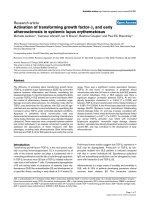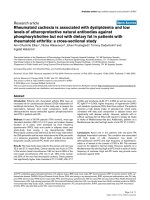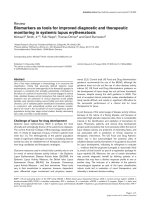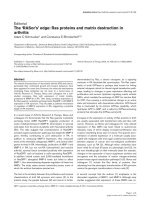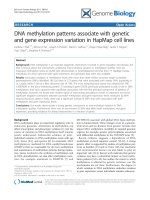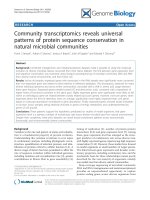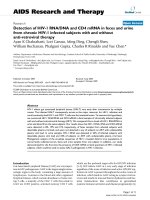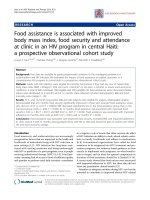Báo cáo y học: "Adam33 polymorphisms are associated with COPD and lung function in long-term tobacco smokers" pdf
Bạn đang xem bản rút gọn của tài liệu. Xem và tải ngay bản đầy đủ của tài liệu tại đây (415.32 KB, 9 trang )
BioMed Central
Page 1 of 9
(page number not for citation purposes)
Respiratory Research
Open Access
Research
Adam33 polymorphisms are associated with COPD and lung
function in long-term tobacco smokers
Alireza Sadeghnejad*
1
, Jill A Ohar
1
, Siqun L Zheng
1
, David A Sterling
2
,
Gregory A Hawkins
1
, Deborah A Meyers
1
and Eugene R Bleecker*
1
Address:
1
Center for Human Genomics and Department of Medicine and Pediatrics, Wake Forest University School of Medicine, Winston-Salem,
North Carolina, USA and
2
School of Public Health, Saint Louis University, St. Louis, Missouri, USA
Email: Alireza Sadeghnejad* - ; Jill A Ohar - ; Siqun L Zheng - ;
David A Sterling - ; Gregory A Hawkins - ; Deborah A Meyers - ;
Eugene R Bleecker* -
* Corresponding authors
Abstract
Background: Variation in ADAM33 has been shown to be important in the development of
asthma and altered lung function. This relationship however, has not been investigated in the
population susceptible to COPD; long term tobacco smokers. We evaluated the association
between polymorphisms in ADAM33 gene with COPD and lung function in long term tobacco
smokers.
Methods: Caucasian subjects, at least 50 year old, who smoked ≥ 20 pack-years (n = 880) were
genotyped for 25 single nucleotide polymorphisms (SNPs) in ADAM33. COPD was defined as an
FEV1/FVC ratio < 70% and percent-predicted (pp)FEV1 < 75% (n = 287). The control group had
an FEV1/FVC ratio ≥ 70% and ppFEV
1
≥ 80% (n = 311) despite ≥ 20 pack years of smoking. Logistic
and linear regressions were used for the analysis. Age, sex, and smoking status were considered as
potential confounders.
Results: Five SNPs in ADAM33 were associated with COPD (Q-1, intronic: p < 0.003; S1, Ile →
Val: p < 0.003; S2, Gly → Gly: p < 0.04; V-1 intronic: p < 0.002; V4, in 3' untranslated region: p <
0.007). Q-1, S1 and V-1 were also associated with ppFEV1, FEV1/FVC ratio and ppFEF25–75 (p
values 0.001 – 0.02). S2 was associated with FEV1/FVC ratio (p < 0.05). The association between
S1 and residual volume revealed a trend toward significance (p value < 0.07). Linkage disequilibrium
and haplotype analyses suggested that S1 had the strongest degree of association with COPD and
pulmonary function abnormalities.
Conclusion: Five SNPs in ADAM33 were associated with COPD and lung function in long-term
smokers. Functional studies will be needed to evaluate the biologic significance of these
polymorphisms in the pathogenesis of COPD.
Published: 12 March 2009
Respiratory Research 2009, 10:21 doi:10.1186/1465-9921-10-21
Received: 18 August 2008
Accepted: 12 March 2009
This article is available from: />© 2009 Sadeghnejad et al; licensee BioMed Central Ltd.
This is an Open Access article distributed under the terms of the Creative Commons Attribution License ( />),
which permits unrestricted use, distribution, and reproduction in any medium, provided the original work is properly cited.
Respiratory Research 2009, 10:21 />Page 2 of 9
(page number not for citation purposes)
Background
Chronic Obstructive Pulmonary Disease (COPD) is a dis-
order that is characterized by progressive decline in lung
function. The rate of decline in FEV1 in long term tobacco
smokers who are susceptible to tobacco smoke is 3–5 fold
that of the normal age related decline [1,2]. Nearly 90% of
COPD is caused by long term cigarette smoking; however,
only 25% of chronic tobacco smokers develop COPD [3].
Tobacco exposure in pack years correlates weakly with
FEV1 [4] however, this relationship only partially explains
reduced lung function in cigarette smokers with COPD.
Furthermore, hyperinflation indicated by an enlarged
residual volume is present in a subset of individuals with
COPD while others manifest primarily a chronic bron-
chitic phenotype. Thus, host or genetic factors appear to
predispose some individuals with tobacco exposure to the
development of smoking related respiratory disease.
Additionally, COPD tends to occur more frequently in
smokers with a family history of obstructive airways disor-
ders such as asthma and COPD. Thus, it has been sug-
gested that asthma and COPD may share some
predisposing factors and some clinical characteristics (The
Dutch hypothesis [5-7]).
In 2002, van Eerdewegh and coworkers identified
ADAM33 as a susceptibility gene for asthma and bron-
chial hyperresponsivess on chromosome 20 p using posi-
tional cloning techniques [8]. While a number of studies
have replicated this finding showing that ADAM33 is a
susceptibility gene for asthma in different populations [9-
12], some studies have not replicated these findings
[13,14]. In addition variation in this gene was shown to
be associated with an accelerated rate of decline in FEV1
in a longitudinal study of subjects with a clinical diagnosis
of asthma [15] and with reduced lung function in a pro-
spective birth cohort study [16]. In a longitudinal study
from a general population, van Diemen and coworkers
showed associations between SNPs in ADAM33 and
annual decline in FEV1 in cigarette smokers who were
compared to the larger population[17]. These studies did
not comprehensively investigate the genetic variations
observed in the ADAM33 gene and were not performed in
a population of chronic cigarette smoker, the appropriate
target population for studies of genetic susceptibility in
COPD. Therefore, we comprehensively assessed ADAM33
variation (25 SNPs) in a large well characterized popula-
tion of long term tobacco smokers and investigated the
associations between these variations and COPD and
spirometric variables.
Methods
Population and data
Subjects were recruited from a cohort of tradesmen
referred for a work-related independent medical evalua-
tion [18]. Referrals were come from trade unions as well
as television and newspaper advertisements. Participants
gave informed consent for their involvement in the
genetic study, and the research protocol was reviewed and
approved by the institutional review boards at Wake For-
est University and Saint Louis University. As part of the
referral process, an extensive questionnaire, a chest radio-
graph, and pulmonary function testing were obtained.
The questionnaire (additional file 1) detailed information
about prior employment, smoking history, and personal
and family medical histories. The questionnaire was self-
administered prior to evaluation, and the physician exam-
iner reviewed the entire questionnaire at the time of exam-
ination. Subjects were asked to quantify their cigarette
smoking as packs per day, and ages of initiation and ces-
sation of tobacco use. Chest radiographs were obtained
and interpreted by a certified B-reader. Chest radiograph
abnormalities were quantified according to the Interna-
tional Labor Organization (ILO) scoring system [19].
Lung function was measured at a variety of accredited hos-
pital pulmonary function laboratories using equipment
available at those sites. Pulmonary function testing was
performed according to American Thoracic Society pub-
lished guidelines [20]. Residual volume (RV) using He
dilution was measured in a subset of subjects (FVC ≤ 80%
predicted) to confirm the presence of restriction or hyper-
inflation [21]. Prebronchodilator spirometric data was
used in the analysis.
For the current study, subjects over 50 years of age with a
greater than or equal to 20 pack-year history of cigarette
smoking were included in the analysis. We did not geno-
type any subject who was not a smoker or smoked less
than 20 pack-years. The presence of evident occupational
exposure induced lung disease (ILO scores greater than 1/
1, 89 subjects), mesothelioma, and an anticipated survival
of less than one year secondary to active cancer, or other
chronic diseases (226 subjects) were exclusion criteria.
COPD phenotype
The COPD phenotype, is a composite variable based on
the GOLD guidelines [21]. However, to avoid a possible
misclassification in the analyses, we classified COPD cases
by using more stringent criteria. COPD was defined as an
FEV1/FVC ratio < 70% and percent-predicted (pp)FEV
1
<
75% (GOLD guideline criteria for stage 2 and above:
FEV1/FVC ratio < 70% and ppFEV
1
< 80%). Controls had
an FEV1/FVC ratio ≥ 70% and ppFEV
1
≥ 80%. Subjects
who fell into the category with FEV1/FVC ratio ≥ 70% and
ppFEV
1
< 80%, or FEV1/FVC ratio < 70% and ppFEV
1
≥
75%, unclassified smokers, were excluded from categori-
cal analyses (COPD vs. unaffected smokers) but included
in additional analyses of continuous variables (quantita-
tive traits: ppFEV
1
, FVC, FEV1/FVC ratio and ppFEF25–
75).
Respiratory Research 2009, 10:21 />Page 3 of 9
(page number not for citation purposes)
Genotyping method
To further characterize the ADAM33 gene, we genotyped
the target population for 25 SNPs in the gene chosen
based on the Hapmap data and supplemented by SNPs
reported in previous studies (25 SNPs). SNP genotyping
was performed using the MassARRAY SNP genotyping sys-
tem (Sequenom, Inc., San Diego CA) which utilizes a
primer extension assay followed by mass spectrometry for
oligonucleotide size determination. PCR and extension
primers were designed using SpectroDesigner software
(Sequenom, Inc.) and reactions were performed accord-
ing to the manufacturer's instructions. Genotypes were
scored automatically using the SpectroTyper software
(Sequenom, Inc.), and checked with quality control sam-
ples (i.e., duplicate DNA samples, negative controls) man-
ually. All polymorphisms were assessed to determine if
the observed genotype frequencies were consistent with
Hardy-Weinberg equilibrium using Chi-square tests. Pair-
wise marker-linkage disequilibrium was estimated using
Lewontin's D' statistic and r
2
[22].
Data analysis
We included 19 SNPs in ADAM33 that had a MAF ≥ 0.05.
The data analysis was performed in two stages. In the first
stage we evaluated the association between the SNPs and
COPD assuming an additive genetic model. In the next
step we explored their relationship between the SNPs that
reached a nominal statistical significance (p value < 0.05)
in the first step, with pulmonary function measurements.
We combined minor allele homozygotes with heterozy-
gotes at this step as they were either absent or had very low
frequencies. As we considered the second step in the anal-
ysis to be exploratory and because of the fact that COPD
and pulmonary function measurements are highly corre-
lated we corrected for multiple comparison testing based
on our analysis in the first step. Therefore the Bonferroni
corrected p-value was calculated as 0.05/19 (0.0026).
The association between ADAM33 genotypes and COPD
having unaffected smoking as controls was evaluated by
Logistic regression. We controlled for sex, age and pack-
years smoked. To test for association we used Chi-square
test for trend, assuming that the risk of the heterozygote
genotype is between the risks of the major and the minor
homozygote genotypes: additive genetic model. General-
ized linear models (linear regression), adjusted for sex,
age and pack-years smoked were used to assess the associ-
ations between SNPs and the pulmonary function meas-
urements: pp (percent predicted) FEV
1
, ppFVC, FEV1/FVC
ratio, ppFEF
25–75
and percent predicted residual volume
(ppRV). In the quantitative trait analyses for each SNP, we
combined the heterozygote genotype with the minor
homozygote genotype as they showed a similar effect in
primary analysis. Statistical analysis was performed using
SAS software (SAS Institute, Cary, N.C.).
Haplotype analysis for the SNPs genotyped was per-
formed using a 3 SNP sliding window approach. Tests for
association between haplotypes and COPD were per-
formed using a score test as implemented in the computer
program HAPLO.SCORE />mayo/research/schaid_lab/upload/
README.haplo.stats[23].
Results
Of the 880 subjects genotyped 97% of the subjects were
men. Of these, 281 fell into the group excluded from cat-
egorical analyses (FEV1/FVC ratio ≥ 70% and ppFEV
1
<
80% or FEV1/FVC ratio < 70% and ppFEV
1
≥ 75%). The
clinical characteristics of the groups with COPD, unaf-
fected smoking controls and the unclassified cigarette
smokers are shown in Table 1. They differed by FEV
1
,
FEV1/FVC ratio and ppFEV
1
because of the phenotype def-
inition. Subjects with COPD were slightly older (67.3 vs.
64.4) and smoked 58.6 pack years compared with 45.9
Table 1: Characteristics of subjects with COPD, smokers with normal pulmonary function and the unclassified* group
UNAFFECTED SMOKERS
(ppFEV
1
≥ 80 and FEV
1
/FVC ratio(%) ≥ 70, n
= 311)
COPD
(ppFEV
1
< 75 and FEV
1
/FVC
(%) < 70, n = 287)
Unclassified*
n = 281
Mean, SD Mean, SD Mean, SD p Value
†
pack years 45.9, 24.7 58.6, 31.1 55.3, 28.3 <0.001
Age 64.4, 10.0 67.3, 8.0 66.1, 9.4 <0.001
FEV
1
(L/sec) 3.1, 0.5 1.7, 0.6 2.5, 0.53 <0.001
ppFEV
1
94.7, 10.1 53.5, 14.0 75.9, 12.9 <0.001
FEV
1
/FVC (%) 78.3, 6.0 55.3, 10.8 52.4, 17.7 <0.001
ppFEF
25–75
85.5, 23.6 26.6, 13.4 71.1, 7.73 <0.001
% male 95.8 97.2 98.2 0.22
*Of 880 Caucasian who smoked ≥ 20 pack years and were older than 50 years, 281 fell into the group excluded from categorical analyses (FEV1/
FVC ratio ≥ 70% and ppFEV
1
< 80% or FEV1/FVC ratio < 70% and ppFEV
1
≥ 75%, unclassified). The analysis shows significant differences in age, and
pack years smoked. ppFEV
1
, FEV1/FVC ratio, and ppFEF
25–75
were different due to selection criteria.
† Chi-square for sex and ANOVA for the rest of the variables
Respiratory Research 2009, 10:21 />Page 4 of 9
(page number not for citation purposes)
pack years in unaffected smokers (Table 1). Smoking his-
tory in pack years correlated significantly (p < 0.0001)
with ppFEV
1
.
All genotype frequencies were consistent with Hardy-
Weinberg equilibrium (p value > 0.05). We observed sig-
nificant evidence (p value < 0.05) for association between
5 SNPs in ADAM33 (Q-1, rs6127096, p < 0.0028; S1,
rs391839, p < 0.0025; S2, rs528557, p < 0.0326; V-1,
rs543749, p < 0.0011 and V-4, rs2787094, p < 0.0068,
Table 2) and the composite variable for COPD (FEV1/FVC
ratio < 70% and ppFEV
1
< 75%, Figure 1). For these five
SNPs, subjects homozygous for the common major allele
were more frequent in the COPD group (Figure 1). Inclu-
sion of potential confounders, age, sex, pack-years
smoked, smoking status (current versus ex-smoker) and
ILO score did not affect the results. After Bonferroni cor-
rection, only SNPs S1 and V-1 were significant (p value <
0.0026, based on 19 tests).
For Q-1, S1 and V-1, quantitative measurements, ppFEV
1
,
FEV1/FVC ratio and ppFEF
25–7
, were significantly different
between the common homozygous genotypes and other
genotypes (dominant genetic model) (Table 3). S2 was
associated only with FEV1/FVC ratio and V-4 was not
associated with any of the quantitative measurements of
pulmonary function (Table 3). Evaluation of all subjects,
including the 281 subjects who were not characterized as
cases and controls (FEV1/FVC ratio ≥ 70% and ppFEV
1
<
80% or FEV1/FVC ratio < 70% and ppFEV
1
≥ 75%),
revealed similar results for quantitative traits (Table 3,
bold face p values). A subset of this population (n = 453)
had information on percent predicted residual volume
(ppRV). In these subjects the associations between ppRV
and these SNPs showed a trend toward significance only
for S1 (mean ppRV = 132.1 for the common genotype, n
= 379, and ppRV = 118.4 for the less common genotypes,
n = 74, p value < 0.07).
Haplotype analysis for the 19 SNPs with a MAF > 0.05 was
performed using a sliding window to include 3 SNPs at a
time. Haplotypes in three regions of the gene were signif-
icantly associated with COPD (Figure 2). The second and
the third regions included SNPs that showed significance
in individual SNP analysis (Q-1-S1-S2 and V-1-V4, respec-
tively). Eight of the thirteen haplotypes were significantly
associated with COPD included SNPs Q-1, S1 and S2.
SNP S1 was present in six out of these eight SNPs. Linkage
disequilibrium between the SNPs measured as D' and r
2
are provided in supplemental materials (additional file 2
and additional file 3). In general, the correlation between
SNPs was relatively low, but there were high LD measures
between SNPs Q-1, S1 and S2 and V-1
Discussion
In this study we genotyped 880 non-Hispanic whites with
a long-term history of cigarette smoking for 25 SNPs in
ADAM33. Cases were subjects who met GOLD criteria for
stages 2, 3 and 4. The control group for these association
studies included chronic cigarette smokers without evi-
dence of airway obstruction. The analysis showed that 5
SNPs (Q-1, S1, S2, V-1 and V4) in ADAM33 were associ-
ated with COPD in these smokers. Consistent with these
findings, subjects with the rare allele of Q-1, S1, and V-1
had significantly higher values for ppFEV
1
, FEV1/FVC
ratio and ppFEF
25–75
than did subjects with the common
allele.
ADAM33, on chromosome 20p13, was identified by posi-
tional cloning and was shown to be associated with
asthma and bronchial hyper-responsiveness [8]. Since
that original publication several studies have replicated
the association of ADAM33 with asthma
[9,10,12,15,16,24-26]. Howard and coworkers showed an
association of ADAM33 with asthma in ethnically diverse
populations [9].
Since that report, replication studies in subjects derived
from populations in Germany, the United Kingdom,
Japan, Australia and the United States have been pub-
lished [10,12,15]. However, in some studies the associa-
tion between ADAM33 polymorphisms and asthma
susceptibility could not be confirmed [13,14,27].
Previous studies have also demonstrated an association
between ADAM33 polymorphisms and measurements of
lung function. In a cohort of 200 asthma patients fol-
Minor allele frequency of SNPs in ADAM33 that were statis-tically significantly* different between COPD† cases and con-trolsFigure 1
Minor allele frequency of SNPs in ADAM33 that were
statistically significantly* different between COPD†
cases and controls. *p value < 0.05. SNPs S2 and V4 were
not significant after banferroni correction. †COPD: Chronic
Obstructive Pulmonary Disease; defined by defined by an
FEV1/FVC ratio < 70% and ppFEV
1
< 75% (n = 287). Control
group were smokers with an FEV1/FVC ratio ≥ 70% and
ppFEV
1
≥ 80% (n = 311).
Respiratory Research 2009, 10:21 />Page 5 of 9
(page number not for citation purposes)
lowed over 20 years, Jongepier and coworkers genotyped
8 SNPs in ADAM33 and found that the rare alleles of the
SNPs S2, T1 and T2 of ADAM33 were associated with an
excess decline in FEV
1
[15]. On a on a population-based
birth cohort, Simpson and coworkers reported that carri-
ers of the rare allele of F+1 SNP had reduced lung function
at age 3 years. When the recessive model was considered,
SNPs F+1, S1, ST+5, and V4 showed association with
reduced lung function at age 5 years. Using linkage dise-
quilibrium mapping, they found evidence of a significant
causal location between BC+1 and F1 SNPs, at the 5' end
of the gene. Four SNPs were associated with lower FEV
1
(F+1, M+1, T1, and T2). They concluded that polymor-
phisms in ADAM33 predict impaired early-life lung func-
tion.
A relationship between ADAM33 variation and COPD has
also been shown. In a Dutch general population including
smokers and non-smokers, van Diemen and colleagues
genotyped 1390 subject for 8 SNPs in ADAM33. They
defined 186 subjects as COPD GOLD stage 2 or greater
(FEV1/FVC ratio < 70% and ppFEV1 < 80%). This study
showed that individuals homozygous for the minor alle-
les of SNPs S2 and Q-1 and heterozygous for SNP S1 had
an excess annual decline in FEV1 compared to their
respective wild type. They also found a significantly
greater frequency of minor alleles of SNPs F+1, S1, S2, and
T2 in subjects with COPD (n = 186) compared to the
entire general population that included non-smokers.
Using 111 COPD patients from this population, Gosman
et al. suggested association between SNPs ST+5, T1 and
T2, and S2 with airway hyper-responsiveness, higher
numbers of sputum inflammatory cells and CD8 cells in
bronchial biopsies. The Van Diemen study is the only pre-
vious study on the association between ADAM33 and
COPD. As in Van Diemen's report we saw associations
between SNPs Q-1, S1 and S2 and COPD; however with
opposite allele. Other differences between that study and
the current report are the number of COPD subjects (186
versus 288), the type of control group for COPD (general
population vs smokers) and the number of SNPs studied
(8 vs 25). Indeed, we believe that the most appropriate
control group for studies on COPD should consist of
chronic cigarette smokers who are at risk for COPD and
yet have normal lung function. To this end, the controls in
this report have comparable exposure to tobacco smoke as
the affected cases.
The five SNPs that reached statistical significance in our
analyses (Q-1, S1, S2, V-1 and V4) were among SNPs that
were reported to be significant in the initial report by Van
Eerdewegh and coworkers. Furthermore, the allele fre-
quency in both controls and cases are comparable
between this report and Van Eerdewegh (cases having
COPD and asthma, respectively, Table 4). Frequencies of
Table 2: Associations* between SNPs in ADAM33 gene and
COPD
COPD Controls
SNP Genotype N % N % p value*
rs2853211 GG 16 5 20 6
(IVS1_729) GC 90 31 105 34 0.4083
(AB+) CC 180 63 185 60
rs4987245 AA 3 1 1 0
(IVS1_379) AG 51 18 45 15 0.1522
GG 231 81 261 85
rs570269 GG 14 05 10 3
(IVS2_488) GC 81 28 93 30 0.736
CC 190 67 205 66
rs487377 AA 15 3 11 5
(IVS2_1141) AG 97 29 90 34 0.0826
(BC+1) GG 174 67 208 61
rs2853210 AA 9 3 13 4
(IVS2_421) AG 99 35 121 39 0.1519
GG 178 62 175 57
rs511898 AA 35 12 44 14
(IVS6_66) AG 116 41 136 44 0.2042
(F+1) GG 134 47 129 42
rs3918395 TT 5 2 4 1
(IVS13_35) GT 67 24 74 24 0.8832
(M+1) GG 212 75 231 75
rs612709 TT 4 1 5 2
(IVS16_21) CT 54 19 94 30 0.0028
(Q-1) CC 226 80 210 48
rs3918396 AA 2 1 3 1
(Ile710val) AG 35 12 68 22 0.0025†
(S1) GG 247 87 237 77
rs528557 CC 17 6 27 9
(Gly717Gly) CG 107 38 133 43 0.0326
(S2) GG 160 56 148 48
rs2853209 TT 60 21 77 25
(IVS19_181) AT 144 50 162 52 0.0921
AA 81 28 70 23
rs598418 CC 38 13 31 10
(IVS19_384) CT 147 52 153 49 0.1062
TT 100 35 125 40
rs44707 CC 49 17 42 13
(IVS19_427) CA 143 50 151 49 0.1554
(ST+4) AA 94 33 115 37
rs574174 AA 7 2 12 4
(IVS19_959) GA 79 28 102 33 0.0731
(ST+7) GG 199 70 196 63
rs2280091 CC 6 2 5 1
(Met738Thr) CT 69 24 77 25 0.8823
(T1) TT 223 74 211 73
rs678881 GG 19 7 12 4
Respiratory Research 2009, 10:21 />Page 6 of 9
(page number not for citation purposes)
S2, V-1 and V4 were also comparable to Howard et al [9].
However, the risk alleles in our study were opposite to
what were reported by Simpson and van Diemen [16,17].
These five SNPs are confined to two regions in ADAM33
gene (one containing Q-1, S1 and S2 and the other con-
taining V-1 and V4). SNPs Q-1, S1 and S2 are in a block
and SNP V-1, although more than 2 kb apart, has high LD
measurements (D' = 1 and 0.39 ≤ r
2
≤ 0.90) with the SNPs
in this block. SNP V4 is neither in a block with its neigh-
boring SNP V1 nor in LD with either of Q-1, S1 or S2. Fur-
thermore, SNP V4 was not associated with any of the lung
function measurements. With regard to location and func-
tion, SNPs Q-1 and V-1 are in intronic regions, S1 is a
non-synonymous and S2 is a synonymous SNP. It is of
importance that haplotype analysis showed that S1 was
present in 6 out of 13 significant haplotypes. Three of the
six haplotypes containing S1 had a frequency of more
than 70%, unlike any other SNP. Additionally, S1 was the
only SNP whose association with residual volume
approached significance (p < 0.07) in a subset of the stud-
ied population. While it is possible that Q-1 and V-1 have
some effect on mRNA splicing, we hypothesize that S1
accounts for the association with COPD. However, defin-
itive identification of the specific SNP associated with
COPD requires functional analysis.
There is some functional data on ADAM33 protein. For
example, Foley et al [28]. reported that the ADAM33
mRNA expression was significantly higher in both moder-
ate and severe asthma compared with mild asthma and
controls(p < 0.05). Additionally, immunostaining for
ADAM33 was increased in the epithelium, submucosal
cells, and smooth muscle in severe asthma compared with
mild disease and controls and in bronchial bud during
airway morphogenesis. ADAM33 is a disintegrin within
the metalloproteinase family. Its association with fetal
lung morphogenesis and accelerated rate of decline in
FEV1 in adults suggests a role in airway remodeling.
Hypothesized mechanisms include release or activation
(IVS21_143) CG 116 41 115 37 0.0592
CC 149 52 182 59
rs2787094 GG 10 4 18 6
(3UTR_449) CG 90 31 123 40 0.0068
(V4) CC 186 65 168 54
rs543749 AA 2 1 4 1
(IVS21_32) AC 52 18 90 29 0.0011†
(V-1) CC 233 81 214 69
rs677044 CC 16 6 17 5
(3UTR_179) TC 99 35 98 32 0.4908
TT 170 60 195 63
*Chi-square test for trend, assuming an additive model (that the risk of the
heterozygote genotype is between the risks of the major and the minor
homozygote genotypes).
†Significant after Bonferroni correction.
The following SNPs: rs11905870, rs621394, rs17513895, rs615436,
rs3918392 and rs3918400 had a minor allele frequency < 0.05 in this
population. COPD was associated with the Q-1, S1, S2, V-1 and V4
genotypes. COPD was defined by an FEV1/FVC ratio < 70% and ppFEV
1
<
75% (n = 287). Control group were smokers with an FEV1/FVC ratio ≥ 70%
and ppFEV
1
≥ 80% (n = 311).
Table 2: Associations* between SNPs in ADAM33 gene and
COPD (Continued)
Table 3: Estimated* mean pulmonary function measurements for genotypes of SNPs in ADAM33 gene that were associated with
COPD.
SNP Genotype ppFEV1 p value* ppFVC p value* Ratio p value* ppFEF25–75 p value*
rs612709 CT+TT 78.62 0.0135 84.49 0.2610 69.88 0.0044 64.52 0.0015
(Q-1) CC† 73.72 0.0132 83.36 0.3093 66.42 0.0122 55.00 0.0012
rs3918396 AG+AA 79.08 0.0256 83.85 0.2883 70.35 0.0068 64.84 0.0079
(S1) GG† 74.17 0.0143 83.93 0.2710 66.69 0.0112 56.00 0.0019
rs528557 CG+CC 75.94 0.2342 84.91 0.8372 68.38 0.0425 59.51 0.1131
(S2) GG† 74.26 0.1571 83.49 0.6225 66.42 0.1329 55.80 0.1594
rs543749 CA+AA 79.08 0.0083 85.20 0.2085 69.96 0.0050 65.17 0.0009
(V-1) CC† 73.57 0.0057 83.42 0.2211 66.40 0.0116 54.76 0.0004
rs2787094 CG+GG 76.50 0.1501 85.14 0.3591 68.32 0.1229 60.54 0.0568
(V4) CC† 73.92 0.1697 83.61 0.5695 66.63 0.1756 55.32 0.0344
COPD: Chronic Obstructive Pulmonary Disease; defined by an FEV1/FVC ratio < 70% and ppFEV
1
< 75% (n = 287). Control group were smokers
with an FEV1/FVC ratio ≥ 70% and ppFEV
1
≥ 80% (n = 311).
ppFEV1: percent predicted Forced Expiratory Volume at the First second.
ppFVC: percent predicted Forced Vital Capacity.
Ratio: FEV1/FVC ratio.
ppFEF25–75: Forced Expiratory Flow 25–75%.
* Generalized linear models, adjusted for sex, age and pack-year smoked. Values in bold are pertinent to all subjects (n = 880).
† Major allele homozygous.
Respiratory Research 2009, 10:21 />Page 7 of 9
(page number not for citation purposes)
of growth factors and facilitation of migration of fibrob-
lasts or inflammatory cells through the matrix. The trend
towards association of ADAM33 with RV is consistent
with a role for ADAM33 in airway remodeling that will
require study with larger numbers to confirm.
Unique strengths of this study were having the proper
control subjects, i.e. smokers susceptible to develop
COPD, and a thorough SNP panel. A limitation of our
study was that we did not formally test for population
stratification.
In summary, we evaluated a well characterized group of
cases and controls who were long term tobacco smokers
and comprehensively genotyped them for ADAM33 vari-
ation. Five polymorphisms: Q-1, S1, S2, V-1 and V4 in
ADAM33 were associated with COPD. When we applied
Bonferroni correction, only SNPs S1 and V-1 hold statisti-
cal significance. SNPs Q-1, S1 and S2 were within 500 bp
and in a haplotype block. SNP V-1 was 2 kb apart from
this block but revealed high linkage disequilibrium meas-
urements with this block. These four SNPs (Q-1, S1, S2
and V-1) were also associated with lung function measure-
ments. SNP V4 was neither linked to the other four SNPs
nor was it associated with lung function. Based on these
data and the fact that S1 is a non-synonymous SNP (Iso-
leucine → Valine), studies to assess the functional signifi-
cance of this amino acid change in the ADAM33 protein
Haplotype analysis using a sliding window of three SNPs at a time for 19 SNPs with a MAF ≥ 5% in ADAM33 gene, having COPD as the phenotype of interestFigure 2
Haplotype analysis using a sliding window of three SNPs at a time for 19 SNPs with a MAF ≥ 5% in ADAM33
gene, having COPD as the phenotype of interest.
Table 4: Comparison of minor allele frequencies between the
current study and the original report on ADAM33
COPD Van Eerdewegh, All
SNP Controls Cases Controls Cases
Q-1 (rs612709) 0.168 0.105 0.150 0.088
S1 (rs3918396) 0.120 0.070 0.105 0.054
S2 (rs528557) 0.304 0.250 0.262 0.200
V-1 (rs543749) 0.159 0.100 0.148 0.076
V4 (rs2787094) 0.257 0.195 0.233 0.164
Respiratory Research 2009, 10:21 />Page 8 of 9
(page number not for citation purposes)
and other functional assays are necessary to understand
the biologic basis for the association of ADAM33 varia-
tion and obstructive pulmonary diseases.
Competing interests
The authors declare that they have no competing interests.
Authors' contributions
JO and DAS established the population. ERB, DAM and
JO planned the current study. AS and DAM designed and
conducted the statistical analyses. AS compiled the results.
GAH and SLZ performed genotyping. All authors contrib-
uted in writing the manuscript and approved the final ver-
sion.
Additional material
Acknowledgements
This study was funded in part by The Selikoff Fund for Environmental and
Occupational Cancer Research, Saint Louis University
References
1. Fletcher C, Peto R: The natural history of chronic airflow
obstruction. British medical journal 1977, 1(6077):1645-1648.
2. Anthonisen NR, Connett JE, Kiley JP, Altose MD, Bailey WC, Buist
AS, Conway WA Jr, Enright PL, Kanner RE, O'Hara P, et al.: Effects
of smoking intervention and the use of an inhaled anticholin-
ergic bronchodilator on the rate of decline of FEV1. The
Lung Health Study. Jama 1994, 272(19):1497-1505.
3. Lokke A, Lange P, Scharling H, Fabricius P, Vestbo J: Developing
COPD: a 25 year follow up study of the general population.
Thorax 2006, 61(11):935-939.
4. Sadeghnejad A, Meyers DA, Bottai M, Sterling DA, Bleecker ER, Ohar
JA: IL13 Promoter Polymorphism -1112C/T Modulates the
Adverse Effect of Tobacco Smoking on Lung Function. Amer-
ican journal of respiratory and critical care medicine 2007.
5. Bleecker ER: Similarities and differences in asthma and
COPD. The Dutch hypothesis. Chest 2004, 126(2
Suppl):93S-95S. discussion 159S–161S
6. Meyers DA, Larj MJ, Lange L: Genetics of asthma and COPD.
Similar results for different phenotypes. Chest 2004, 126(2
Suppl):105S-110S. discussion 159S–161S
7. Postma DS, Boezen HM: Rationale for the Dutch hypothesis.
Allergy and airway hyperresponsiveness as genetic factors
and their interaction with environment in the development
of asthma and COPD. Chest 2004, 126(2 Suppl):96S-104S. dis-
cussion 159S–161S
8. Van Eerdewegh P, Little RD, Dupuis J, Del Mastro RG, Falls K, Simon
J, Torrey D, Pandit S, McKenny J, Braunschweiger K, et al.: Associa-
tion of the ADAM33 gene with asthma and bronchial hyper-
responsiveness. Nature 2002, 418(6896):426-430.
9. Howard TD, Postma DS, Jongepier H, Moore WC, Koppelman GH,
Zheng SL, Xu J, Bleecker ER, Meyers DA: Association of a disin-
tegrin and metalloprotease 33 (ADAM33) gene with asthma
in ethnically diverse populations. The Journal of allergy and clinical
immunology 2003, 112(4):
717-722.
10. Blakey J, Halapi E, Bjornsdottir US, Wheatley A, Kristinsson S,
Upmanyu R, Stefansson K, Hakonarson H, Hall IP: Contribution of
ADAM33 polymorphisms to the population risk of asthma.
Thorax 2005, 60(4):274-276.
11. Holloway JW, Keith TP, Davies DE, Powell R, Haitchi HM, Holgate
ST: The discovery and role of ADAM33, a new candidate
gene for asthma. Expert reviews in molecular medicine [electronic
resource] 2004, 6(17):1-12.
12. Werner M, Herbon N, Gohlke H, Altmuller J, Knapp M, Heinrich J,
Wjst M: Asthma is associated with single-nucleotide polymor-
phisms in ADAM33. Clin Exp Allergy 2004, 34(1):26-31.
13. Lee JH, Park HS, Park SW, Jang AS, Uh ST, Rhim T, Park CS, Hong SJ,
Holgate ST, Holloway JW, et al.: ADAM33 polymorphism: asso-
ciation with bronchial hyper-responsiveness in Korean asth-
matics. Clin Exp Allergy 2004, 34(6):860-865.
14. Lind DL, Choudhry S, Ung N, Ziv E, Avila PC, Salari K, Ha C, Lovins
EG, Coyle NE, Nazario S, et al.: ADAM33 is not associated with
asthma in Puerto Rican or Mexican populations. American jour-
nal of respiratory and critical care medicine 2003, 168(11):1312-1316.
15. Jongepier H, Boezen HM, Dijkstra A, Howard TD, Vonk JM, Koppel-
man GH, Zheng SL, Meyers DA, Bleecker ER, Postma DS: Polymor-
phisms of the ADAM33 gene are associated with accelerated
lung function decline in asthma. Clin Exp Allergy 2004,
34(5):757-760.
16. Simpson A, Maniatis N, Jury F, Cakebread JA, Lowe LA, Holgate ST,
Woodcock A, Ollier WE, Collins A, Custovic A, et al.: Polymor-
phisms in a disintegrin and metalloprotease 33 (ADAM33)
predict impaired early-life lung function. American journal of res-
piratory and critical care medicine 2005, 172(1):55-60.
17. van Diemen CC, Postma DS, Vonk JM, Bruinenberg M, Schouten JP,
Boezen HM: A disintegrin and metalloprotease 33 polymor-
phisms and lung function decline in the general population.
American journal of respiratory and critical care medicine 2005,
172(3):329-333.
18. Ohar J, Sterling DA, Bleecker E, Donohue J: Changing patterns in
asbestos-induced lung disease. Chest 2004, 125(2):744-753.
19. Labour OI:
ILO international classification of radiographs of
pneumoconiosis: occupational safety and health series, No.
22 revised. In Geneva, Switzerland ; 1980.
20. Standardization of Spirometry, 1994 Update: American Thoracic
Society. American journal of respiratory and critical care medicine 1995,
152(3):1107-1136.
21. Standards for the diagnosis and care of patients with chronic
obstructive pulmonary disease. American Thoracic Society.
American journal of respiratory and critical care medicine 1995, 152(5 Pt
2):S77-121.
22. Lewontin RC: The Interaction of Selection and Linkage. Ii.
Optimum Models. Genetics 1964, 50:757-782.
23. Schaid DJ, Rowland CM, Tines DE, Jacobson RM, Poland GA: Score
tests for association between traits and haplotypes when
linkage phase is ambiguous. American journal of human genetics
2002, 70(2):425-434.
24. Schedel M, Depner M, Schoen C, Weiland SK, Vogelberg C, Nigge-
mann B, Lau S, Illig T, Klopp N, Wahn U, et al.: The role of poly-
morphisms in ADAM33, a disintegrin and metalloprotease
33, in childhood asthma and lung function in two German
populations. Respiratory research 2006, 7:91.
25. Noguchi E, Ohtsuki Y, Tokunaga K, Yamaoka-Sageshima M, Ichikawa
K, Aoki T, Shibasaki M, Arinami T: ADAM33 polymorphisms are
Additional File 1
Asbestos screening. The questionnaire that was used to obtain informa-
tion on study subjects.
Click here for file
[ />9921-10-21-S1.doc]
Additional File 2
D-prime. The figure represents Linkage disequilibrium (D') between
ADAM33 SNPs.
Click here for file
[ />9921-10-21-S2.tiff]
Additional File 3
R-prime. The figure represents Linkage disequilibrium (r
2
) between
ADAM33 SNPs.
Click here for file
[ />9921-10-21-S3.tiff]
Publish with BioMed Central and every
scientist can read your work free of charge
"BioMed Central will be the most significant development for
disseminating the results of biomedical research in our lifetime."
Sir Paul Nurse, Cancer Research UK
Your research papers will be:
available free of charge to the entire biomedical community
peer reviewed and published immediately upon acceptance
cited in PubMed and archived on PubMed Central
yours — you keep the copyright
Submit your manuscript here:
/>BioMedcentral
Respiratory Research 2009, 10:21 />Page 9 of 9
(page number not for citation purposes)
associated with asthma susceptibility in a Japanese popula-
tion. Clin Exp Allergy 2006, 36(5):602-608.
26. Kedda MA, Duffy DL, Bradley B, O'Hehir RE, Thompson PJ:
ADAM33 haplotypes are associated with asthma in a large
Australian population. Eur J Hum Genet 2006, 14(9):1027-1036.
27. Raby BA, Silverman EK, Kwiatkowski DJ, Lange C, Lazarus R, Weiss
ST: ADAM33 polymorphisms and phenotype associations in
childhood asthma. The Journal of allergy and clinical immunology
2004, 113(6):1071-1078.
28. Foley SC, Mogas AK, Olivenstein R, Fiset PO, Chakir J, Bourbeau J,
Ernst P, Lemiere C, Martin JG, Hamid Q: Increased expression of
ADAM33 and ADAM8 with disease progression in asthma.
The Journal of allergy and clinical immunology 2007, 119(4):863-871.

